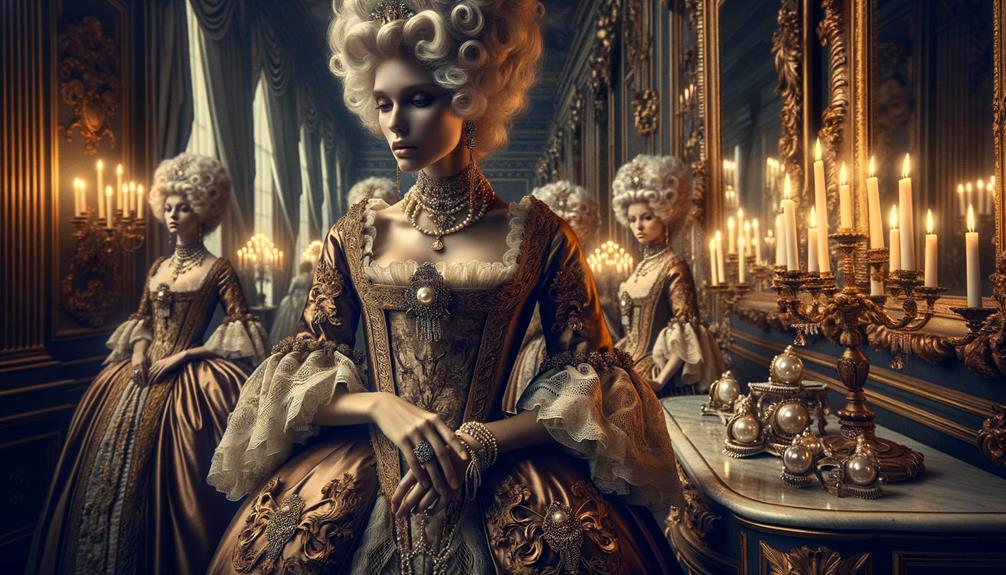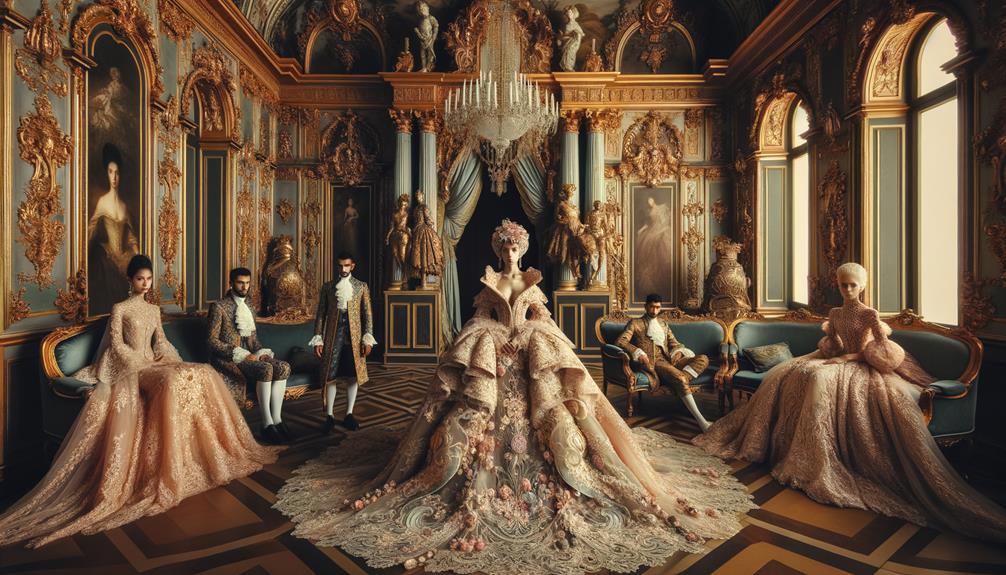Panniers, those bulky structures slung just right at the hips, changed the baroque silhouette. They made hips extravagant and curves elegant, creating an entirely new and mesmerizing shape. Delicate baskets of whalebone or cane transformed into art pieces, with silk, satin, and lace catching the light in captivating ways. These weren't just fashion statements – they were seen in the grand courts of figures like Marie Antoinette and Sophia Magdalena, symbols of status and splendor that have become etched in our cultural memory. Critics may have dismissed them as ridiculous, but their impact is undeniable. If you're curious to learn more, the past holds endless intriguing details waiting to be uncovered.
Evolution of Panniers
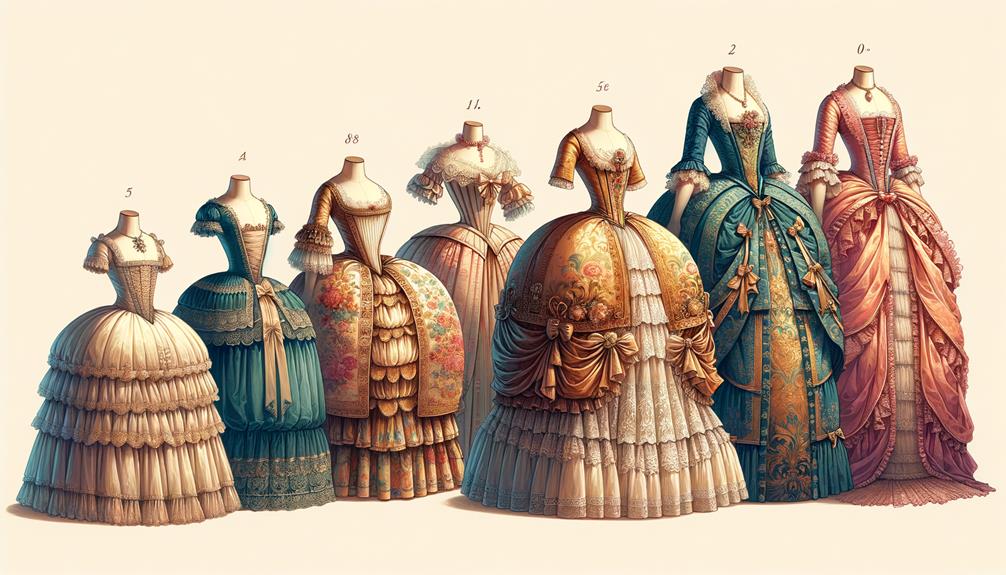
The evolution of panniers transformed the silhouette of 18th-century fashion into an artistic expression of exaggerated hips and elegant curves. The side hoops, known as panniers, redefined the human form in a remarkable way. Unlike the hoop skirt, which couldn't achieve the desired flat front and back, panniers offered a revolutionary shape, creating a stunning Rococo costume.
Panniers were more than just fashion; they were a statement. They consisted of two baskets of whalebone or cane, slung at the hips, resembling the side-slung baskets carried by donkeys. This led to both admiration and satire, as the comparison was inevitable, yet the elegance was undeniable. The wide hips they created became synonymous with the era's aesthetic.
What stood out was the adaptability of panniers. They could be designed with hinges, allowing the lateral extensions to collapse when needed. The springs, regulated by pairs of tapes, adjusted the front-to-back depth. This innovation wasn't just about appearance; it was about functionality.
The transformation wasn't merely external; it was an embodiment of the period's creativity and desire for innovation. The panniers, with their side hoops, became a canvas for the extravagant artistry of 18th-century fashion.
Design and Structure
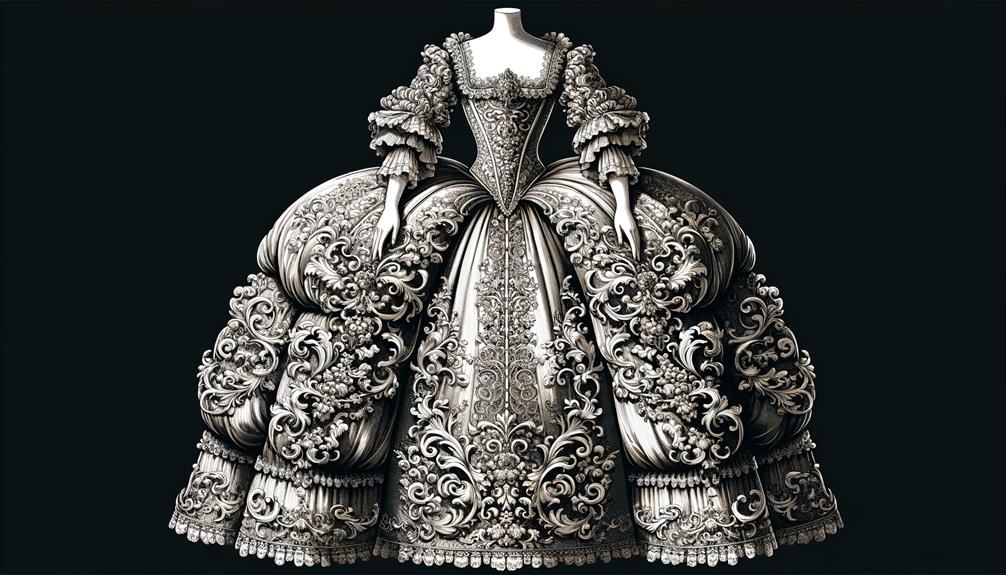
Panniers, those remarkable side baskets worn with 18th-century fashion, were marvels of engineering. Crafted with meticulous attention, they showcased a complexity that belied their simple appearance. Two baskets of whalebone or cane, slung at the hips, gave wearers a pronounced silhouette.
Contrary to their rigid look, these lateral extensions could actually be equipped with hinges. This allowed the front and back depth to be adjusted, providing a customizable fit. Inside, pairs of tapes regulated the spring of the whalebone or caning, ensuring the structure maintained its shape while offering flexibility.
These elements combined to create a striking silhouette without sacrificing mobility. The whalebone or cane baskets enhanced the side profile, offering lightweight durability. The hinges enabled wearers to adapt the panniers to their needs, while the tapes helped preserve the structural integrity.
Unseen beneath the grand robes, panniers were the architectural foundation of the baroque style. Historical artefacts like the Staffordshire figure from c. 1750 and the 1747 triptych painting offer glimpses into this ingenious engineering. The innovative design of panniers continues to inspire awe as we delve deeper into 18th-century fashion.
Fabrics and Materials
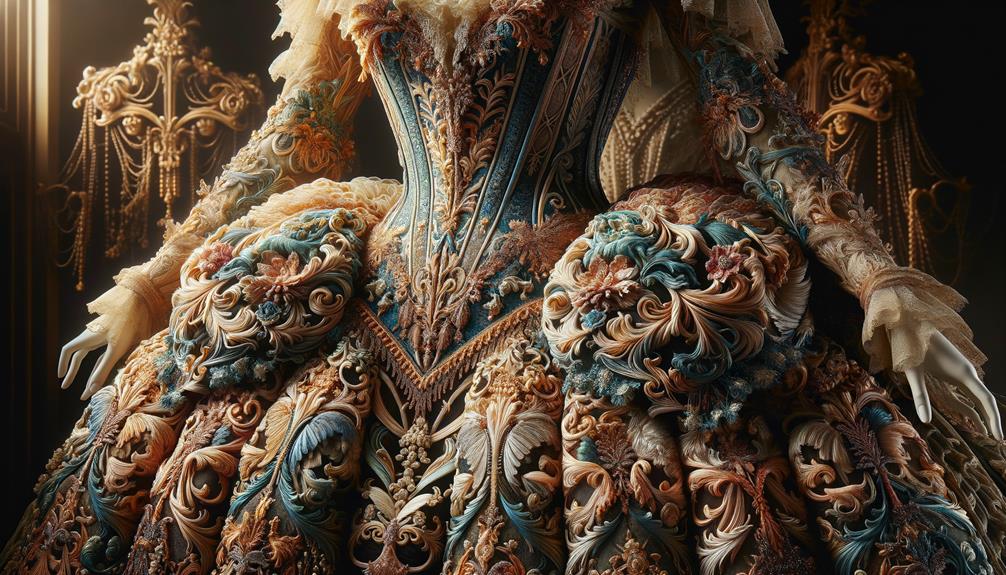
When looking at the materials used in panniers, it's clear the choice of textiles played a crucial role in creating the distinctive baroque silhouette. The wide, structured shape demanded fabrics that could support and enhance this dramatic form.
Sturdy foundations were essential. Whalebone, cane, or steel provided the necessary rigidity to maintain the shape. These almost skeletal materials became the unseen architects of fashion's grandeur.
The outer layers, however, told a different story. Luxurious fabrics like silk, satin, and brocade draped over the frame, adding a visual richness. Their lustrous surfaces captured light, giving depth and movement. These textiles were more than just coverings; they were statements of opulence and refined taste.
For those who appreciate the finer details, decorative trimmings added a delicate touch. Ribbons, lace, and embroidery offered a subtle contrast to the robust structure beneath. These embellishments spoke of craftsmanship and care.
In summary:
- Sturdy materials: Whalebone, cane, steel.
- Luxurious fabrics: Silk, satin, brocade.
- Delicate trimmings: Ribbons, lace, embroidery.
Each element, essential in its own right, worked together to achieve the distinctive wide-sided baroque silhouette, rich in detail.
Cultural Impact
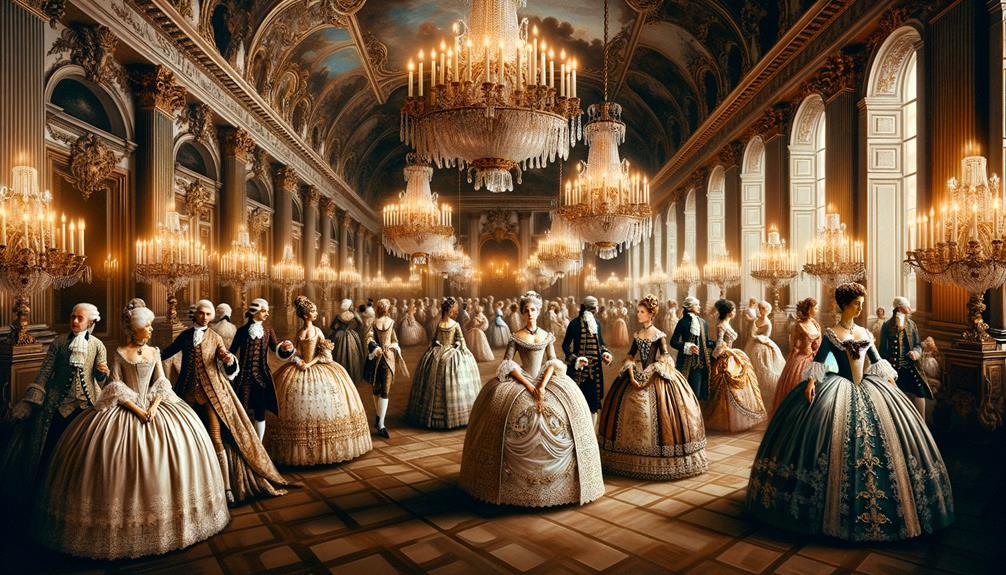
In the 18th century, panniers not only shaped fashion but also mirrored social hierarchies. They became symbols of high status, visually declaring the privilege of European nobility. Marie Antoinette, with her grand panniers, epitomized this extravagant display. Her wide skirts were more than just fabric; they were statements of power and exclusivity.
Critics and satirists saw the grandeur as wasteful, mocking the impracticality of these voluminous garments. Caricatures and plays poked fun at the aristocracy, portraying the silhouette as both ridiculous and excessive. Yet, it wasn't just about the size. The grand pannier delineated the social and physical space women occupied, reinforcing gender norms of the era. Women, encased in their wide skirts, were set apart, both literally and figuratively.
Art and literature imitated the fashion, embedding the grand pannier silhouette into cultural memory. Paintings immortalized the exaggerated shapes, while plays brought the absurdity to life. Museums today preserve these artifacts, showcasing their historical and cultural significance. The pannier, though a relic, continues to spark curiosity, reminding us of an era where fabric and form conveyed profound societal truths.
Famous Wearers
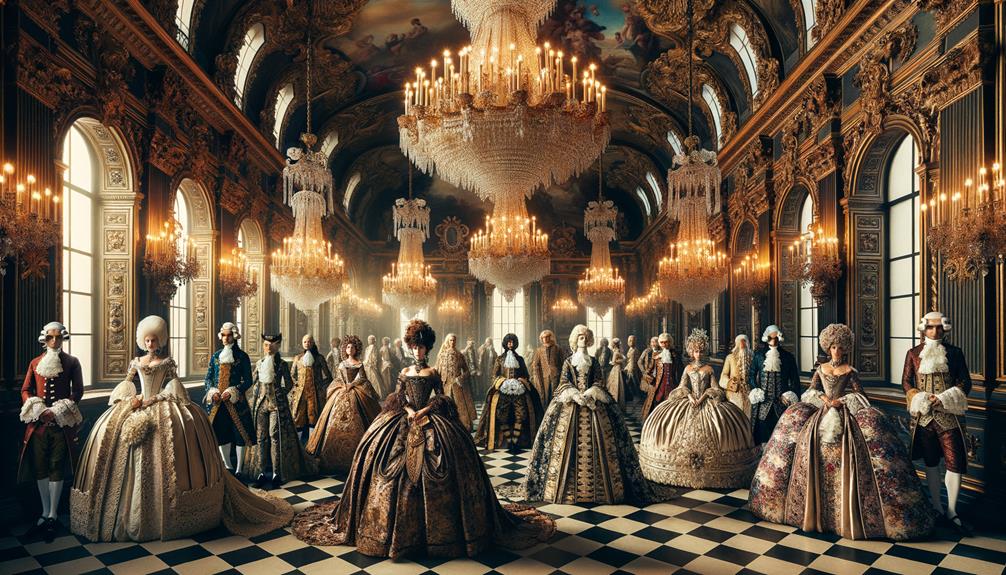
Marie Antoinette's grand panniers were a statement of French royal opulence. Her court dress wasn't just attire – it was a reflection of power and luxury. The wide skirts, supported by panniers, commanded attention, embodying the essence of aristocratic grandeur.
- In 1772, Sophia Magdalena of Sweden's coronation robes, enhanced by panniers, showcased the splendor of the Swedish monarchy. The silhouette spoke volumes without words.
- Crafted in 1755, these German porcelain ballet dancers captured the exaggerated side-to-side proportions of pannier-supported costumes, blending elegance with theatricality.
- The wide pannier skirts worn by the women in the 1747 Ducane Family Portrait portrayed the aristocratic essence of the era, their court dress a visual representation of status.
The Staffordshire figure from around 1750 further exemplifies the fascination with the exaggerated silhouette. Panniers weren't just fashion; they were a form of self-expression. They transformed wearers into living art, each fold and flare a brushstroke on the canvas of high society. These iconic figures remind us that panniers did more than widen silhouettes – they broadened the horizons of style itself.
Modern Interpretations
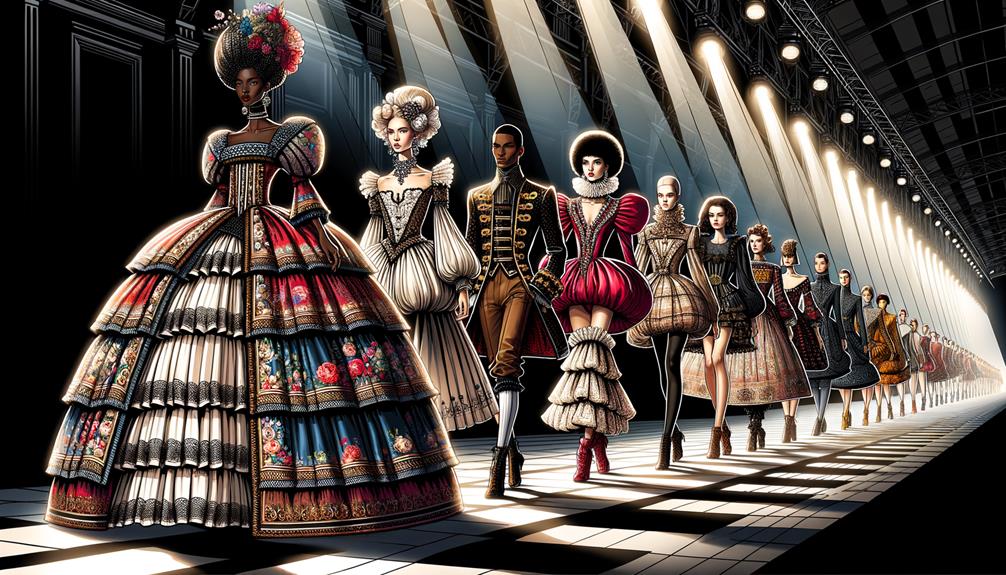
It's fascinating to see how the grand silhouettes of the Marie Antoinette era have influenced Alexander McQueen's Spring 2013 collection. Sarah Burton's designs seamlessly weave history into the fabric of the present, merging the opulence of the past with contemporary innovation. The dresses, with their strikingly wide hips, pay homage to the pannier style that once defined French elegance.
These modern reinterpretations breathe new life into a silhouette that once symbolized grandeur. The updated forms retain the essence of the 18th-century style but with a bold twist. The structured hips create an imposing figure, evoking the drama of Baroque fashion while speaking to today's avant-garde sensibilities.
It's remarkable how the pannier's influence endures. Despite the centuries, its distinctive shape remains relevant in modern fashion collections, demonstrating the cyclical nature of style. Burton's reimagining of the pannier is not mere nostalgia; it's a statement of how historical elements can be adapted, recontextualized, and revitalized.
In these designs, there's a dialogue between eras, a conversation stitched into every seam. The past informs the present, and in doing so, propels us towards an innovative future.
Frequently Asked Questions
Why Were 18TH Century Dresses so Wide?
18th century dresses were designed to be incredibly wide, almost like huge bell shapes. This was done to showcase the wealth and high social standing of the women who wore them. The oversized silhouettes, though impractical for everyday tasks, created an air of grandeur and prestige. Fashion at the time was used as a way to visually express one's position in society – the bigger the dress, the higher the status.
Which Era of Costumes Included Panniered Skirts?
The panniered skirt, with its dramatic, wing-like shape, was a defining feature of the Baroque and Rococo periods. Tracing back to the early 18th century, these grand skirts reached their peak in the French courts of Louis XV and Louis XVI. I can't help but be captivated by their sheer grandeur, a testament to the opulence and extravagance of those eras.
What Was the Prominent Silhouette in the 1700s?
The silhouette of the 1700s was quite striking. Women's skirts flared dramatically at the hips, creating a distinct flat front and back. Delicate fabrics and elaborate Rococo hairstyles completed the look, blending elegance and innovation.
When Were Pannier Invented?
Panniers, those fascinating garment accessories, first gained popularity around 1710, likely originating in Germany or England. These voluminous sidepockets reshaped fashion, dramatically expanding skirts and creating a striking silhouette. It was a bold innovation in the history of dress.
Conclusion
I've traced the history of fashion, from the grandeur of royal courts to the modern runways. Panniers, like the wings of Icarus, lifted silhouettes to soaring heights, only to be pulled back down by gravity. Today, they whisper through fabric, a nod to the opulence of the past. We still wear them, not to escape our roots, but to embrace them. Fashion, like time itself, folds and unfolds, eternally expanding and contracting.


